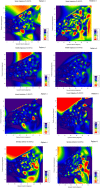Movement Pattern of Scapular Dyskinesis in Symptomatic Overhead Athletes
- PMID: 28747702
- PMCID: PMC5529546
- DOI: 10.1038/s41598-017-06779-8
Movement Pattern of Scapular Dyskinesis in Symptomatic Overhead Athletes
Abstract
This study investigated the characteristics of arm elevation via principal component analysis in symptomatic overhead athletes with scapular dyskinesis. One hundred-thirty-four overhead athletes with scapular dyskinesis [24: inferior angle prominence (pattern I); 46: medial border prominence (pattern II), 64: pattern I + II] were evaluated by three-dimensional electromagnetic motion and electromyography to record the scapular kinematics (upward rotation/posterior tipping/exterior rotation) and muscle activation (upper trapezius: UT; middle trapezius: MT; lower trapezius: LT; serratus anterior: SA) during lowering phase of arm elevation. The results showed: (1) for pattern I and II, the first 3 principal component (PCs) explained 41.4% and 42.6% of total variance of movement; (2) the first PCs were correlated with MT, LT activity (r = 0.41~0.61) and upward rotation, posterior tipping (r = -0.59~-0.33) in pattern I, and UT, MT, SA (r = 0.30~0.70) activity in pattern II; (3) contour plots of muscle activity demonstrated that muscle activities varied with dyskinesis patterns. In summary, for the pattern I, the major characteristics are coactivation of MT and LT and corresponding scapular posterior tipping and upward rotation. For the pattern II, the major characteristics are coactivation of UT, MT and SA without corresponding scapular external rotation.
Conflict of interest statement
The authors declare that they have no competing interests.
Figures
References
-
- Kibler, W. B. et al. Clinical implications of scapular dyskinesis in shoulder injury: the 2013 consensus statement from the ‘Scapular Summit’. Br J Sports Med. 47 (2013). - PubMed
Publication types
MeSH terms
LinkOut - more resources
Full Text Sources
Other Literature Sources


